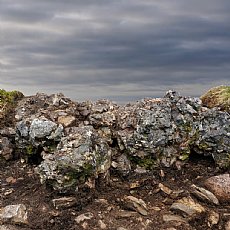Dun Deardail Iron Age hillfort
01 June 2020
- News Type:
- Site of the Month

The Atlas of Hillforts (hillforts.arch.ox.ac.uk) has identified a large number of hillforts in the Highlands, but few have seen modern excavation. The vitrified hillfort of Knockfarrell near Dingwall was one of the first excavations in Scotland in the late 1700s, where walls of 12 feet high could still still be seen. Craig Phadrig in Inverness has seen work over many years, including recent excavation of a part of the rampart which showed Iron Age but also Early Historic and Medieval use.
A larger scale excavation was recently undertaken as part of a community excavation at Dun Deardail in Lochaber, providing valuable information on a west coast hillfort. Like Knockfarrell and Craig Phadraig, it was located on a high hill, with remains of fortifications encircling a large area. The results suggest that the hillfort was built in the 5th century BC, and occupation ended sometime in the 4th to 2nd century BC. In the middle of this period, it was burnt in a fire so hot that it melted the rock (vitrification), a fate shared with Knockfarrell, Craig Pharaig and a number of other hillforts in the Highlands.
The recent excavations for the Nevis Landscape Partnership was funded by Forestry Commission Scotland and the Heritage Lottery Fund, and undertaken by AOC Archaeology with considerable community participation. They explored the terraced interior of the fort and the nature of the rampart walls. These showed that the rampart was much thicker than thought, and probably topped by a substantial timber structure. As in some other hillforts in Scotland, slots for large horizontal timbers were found within the wall, some even preserving charred timbers. After the fire of c. 310BC, the fort was reoccupied, with walls refaced and the interior levelled. Despite a tradition that the fort had been reoccupied in the Early Historic Period, as happened at Craig Phadrig, no evidence was discovered. As a result, the hillfort was probably built, burnt and then abandoned in the Iron Age, in the space of a few centuries.
Clearly there was considerable resources needed to build such a large structure, which was defensive but also a status symbol and prominent symbol of power for miles around. Hearths show occupation in the interior, although the nature of any buildings remained obscure. There were few finds recovered, but included stone tools, metal objects, and evidence that bronze and ironworking had taken place in the hillfort.
The excavation was also notable in extensive environmental sampling, both in trenches occupied as well as a dated core from outside the walls. The waterlogged peat provided good preservation for pollen and charcoal. When published, this will provide valuable information for this area.

© Matt Ritchie
The reason for vitrification at hillforts remains a matter of debate, but was either accidental or deliberate. If deliberate it is still not entirely clear how fires could have been set and maintained to create the high temperatures needed for to melt rock. Science fiction author Arthur C. Clarke maintained this was one of the biggest mysteries he had encountered. Experiments to reproduce vitrification have all failed thus far. The excavations at Dun Deardail have provided further evidence for this ongoing debate.
The excavations at Dun Deardail are important for highlighting aspects of construction at hillforts. It is also significant that dates from the core outside the walls corresponded to the dates in the interior, suggesting possible future strategies for work on hillforts. The project is also a good example of involving local community and schools, as well as creative events running in tandem. Nevertheless a number of questions remain, including the hillfort’s place in the landscape, the nature of subsistence and the structures within.
The report of the excavation is still awaited, but a popular booklet has been produced summarising results (Ritchie 2018).
Further information
Highland HER MHG4348
Ritchie, Matt (ed) 2018 The Archaeology of Dun Deardail. An Iron Age hillfort in Glen Nevis, Forestry Commission Scotland. (Available also to download from MHG4348).
Site of the Month Archive
- 10/04/2021 Easter Raitts township
- 02/03/2021 Lower Slackbuie, Inverness (ASDA) Neolithic site
- 01/02/2021 Balnuaran of Clava cairns
- 04/01/2021 Wilkhouse Inn
- 02/12/2020 Spinningdale Cotton Mill
- 02/11/2020 Skibo A Canadian Forestry Camp
- 01/10/2020 WWI Detonator Store, Dalmore near Invergordon
- 03/09/2020 Mesolithic Shell Midden at Sand, Wester Ross
- 08/08/2020 Kinbeachie Neolithic settlement
- 01/07/2020 Armadale Cist Burial and Stone & Timber Complex
